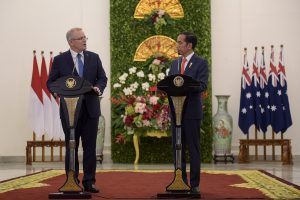The visit of Indonesia’s President Joko “Jokowi” Widodo to Australia this week bodes well for relations with Indonesia. Indeed, relations have improved significantly since a low in the earlier part of the last decade marked by diplomatic rows over issues ranging from political gaffes to phone tapping.
Australia and Indonesia now enjoy cooperation on a growing number of fronts. Both countries inked a strategic partnership agreement in August 2018. Indonesia now considers Australia its preferred partner in the area of security cooperation. They co-chair a subregional forum on counterterrorism.
Australia has committed significant diplomatic resources to Indonesia. In 2017, it opened a consulate in Surabaya, Indonesia’s second-largest city.
They have also signed a free trade agreement, the Indonesia-Australia Comprehensive Economic Partnership Agreement (IA-CEPA). Almost a decade in the making, the long-awaited deal was ratified by Indonesia’s legislature this week.
This is the one area that Jokowi and Prime Minister Scott Morrison must reconcile with an otherwise booming friendship: the state of their economic relations.
For two neighboring G-20 countries with seemingly complementary economies, one would expect higher levels of trade and investment. Indonesia and Australia have the lowest trade volumes of any G-20 pairing.
In 2018, less than 1 percent of Australia’s foreign investment went to Indonesia. Two-way trade with Indonesia has stagnated at around 2 percent for the entire decade.
It is hard to find a satisfying explanation for this. Some advocates of increased business ties chalk it up to cultural differences.
This is difficult to accept given Australia’s success doing business with other countries in Asia, such as Malaysia. Australian universities boast a strong community of academics focused on Indonesia studies. At the grassroots level, people-to-people ties are strong.
Stronger ties between boardrooms are needed. To activate investment and diversity the foundation of bilateral trade, executives need a narrative of Indonesia’s opportunities rather than a litany of its risks. Exchanges of influential business people will pave the way to successful partnerships.
In this context, it’s hard to overstate the importance of IA-CEPA.
One of the aims of the treaty is to increase investor confidence on both sides. The treaty’s Investor State Dispute Settlement (ISDS) mechanism, which establishes a pathway for investors to enforce the protections guaranteed to them under the agreement, is a step in the right direction.
It establishes a system of tariff quotas. For the first time, Australian exporters of key commodities such as live cattle will know how much Indonesia will allow in tariff-free.
IA-CEPA is an achievement, but Australia-Indonesia economic ties sit in a wider regional context. This fact has sharpened cooperation in other areas, and with it, a sense that Indonesia is on the rise and that it is at the center of a dynamic Indo-Pacific region in which both countries have a huge stake.
A regional economic agenda is forthcoming. Their shared participation in the Regional Comprehensive Economic Partnership (RCEP), understood to be on the path to completion this year, will open up new opportunities.
An ambitious step for Indonesia would be accession to the Comprehensive and Progressive Agreement for the Trans-Pacific Partnership (CPTPP). Indonesia’s membership would add considerable economic heft to an agreement currently missing both the United States and China. A motivating factor might be that two of Indonesia’s economic competitors, Vietnam and Malaysia, are founding members of the CPTPP.
A widening infrastructure gap constrains economic growth and integration in the region. Indonesia alone needs billions investment dollars to bridge its own gap. Meanwhile, infrastructure initiatives in the region have emerged as new geopolitical tools to wield influence and snare countries in “debt traps.”
The lack of infrastructure is one convincing explanation for why Indonesia and Australia have low trade ties. While both are close neighbors, their major populations are far apart and there is little connectivity between the two.
The areas closest to one another, eastern Indonesia and northern Australia, remain relatively underdeveloped. Northern Australia suffers from its own infrastructure gap as policymakers try to incentivize development there.
Northern Australia’s potential role in enhancing connectivity with Indonesia must not be overlooked. While Australia’s foreign policy community has focused on the north as a strategic military asset, few have attempted to frame it as a region critical to Australia’s international connectivity.
The leaders of both countries should elevate the framing of their economic cooperation to take a regional view. By working together shape the region’s trade and investment architecture, they can diminish the smaller issues that derailed cooperation in the past.
Kyle Springer is Senior Analyst at the Perth USAsia Centre at The University of Western Australia.
































